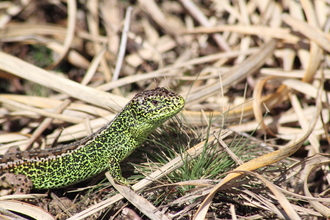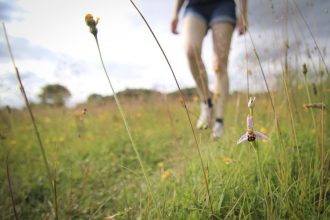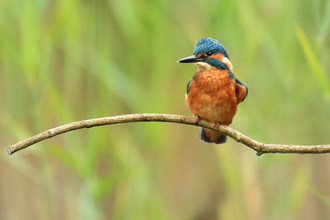Reptiles in the North West of England are just as beautiful and fascinating as those abroad, and in my opinion, are even more alluring – there is something really magical about seeing cold-blooded creatures on home soil.
Meet the reptiles of the North West (and find out where to see them)
Jon Hawkins - Surrey Hills Photography
Lizards in Lancashire, Greater Manchester and North Merseyside
All three of the UK’s native lizard species can be found in the North West, and one in particular is one of the UK’s rarest reptiles.
Common lizard
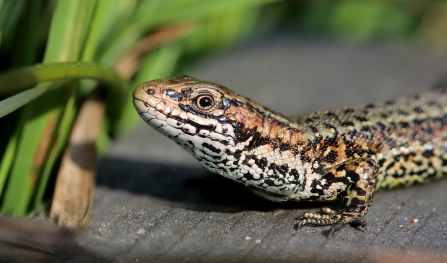
Jon Hawkins - Surrey Hills Photography
As its name suggests, the common lizard is the UK’s most common and widespread reptile and the easiest one to see. It is beautiful: brownish grey with rows of darker spots or stripes along its back or sides. Males have an extra splash of colour in their bright yellow or orange bellies. And how’s this for a fun fact – common lizards give birth to live young after incubating their eggs inside their bodies!
Common lizards can be seen on heathland, moorland, woodland and grassland walks as they bask in sunny spots, and you may even be lucky enough to see them in your garden. They emerge from hibernation in spring and are most active through April and May, when they mate.
Where to see common lizards:
Sand lizard
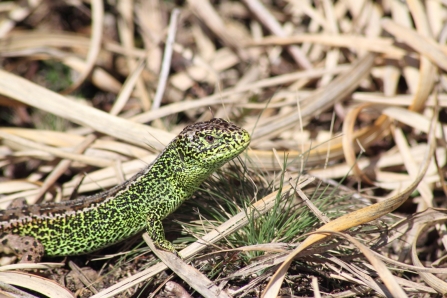
Steve Davis
Unlike the common lizard, the sand lizard is one of the UK’s rarest reptiles and the rarest in the North West. The loss of many of the sandy heath and dune habitats it thrives in have seen numbers plummet. Thankfully reintroduction programmes have helped to establish new populations across the country, while conservation work by our dedicated staff and volunteers has helped the lizards to hold on across Merseyside.
Sand lizards are stunning reptiles. Females are a lovely sandy-brown colour with rows of dark blotches along their backs, while males have bright green flanks that are unmissable during the spring breeding season, when they are at their showiest. Look out for them basking on bare patches of sand.
Where to see sand lizards:
- Freshfield Dune Heath
- Sefton sand dunes (including Formby)
Slow worm
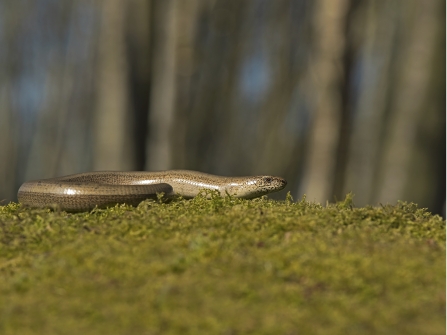
Mark Ollett
The slow worm isn’t a worm, or even a snake, it is actually a legless lizard that sheds its tail when threatened and blinks with its eyelids, just like its leggy cousins. Slow-worms are smaller than snakes and can be identified by their golden-grey skin. Females have some extra camouflage in the form of dark sides and a dark stripe down their backs, while males sometimes sport blue spots!
Slow-worms typically live in heathland and tussocky grassland habitats, as well as woodland edges and rides where they can find invertebrates to eat and a sunny patch to sunbathe in. These lizards are also partial to sheltering and hibernating in compost heaps, so keep your eyes peeled if you have an allotment or mature garden.
Where to see slow-worms:
Snakes in Lancashire, Greater Manchester and North Merseyside
Our snakes tend to be shier and harder to see than the lizards, but that makes a sighting all the more rewarding.
Adder
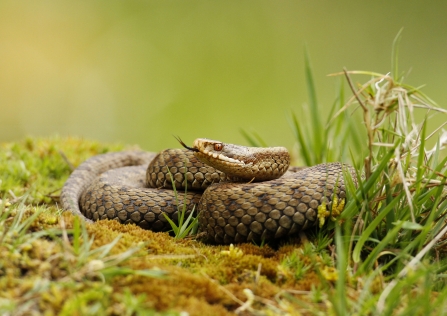
Jon Hawkins - Surrey Hills Photography
There is no mistaking those jewel-like red eyes and that black zig-zag pattern. Adders are incredibly charismatic and completely gorgeous, most commonly spotted basking in the sunshine in woodland glades, on moorlands or on heathlands. They are very shy and will only ever bite as a last form of defence when they are surprised or disturbed, preferring to slither away and hide. Though these snakes are venomous, bites are really only dangerous to the very young, ill or old, causing nothing more than some pain and nasty inflammation in healthy adults.
Male adders perform an incredible ‘dance’ in the spring: a duel that fends off competition for mates. Female adders are easy to tell apart due to their reddish-brown colour (males are more silvery-grey), and like common lizards, incubate their eggs internally. The best time to see adders are the first warm days of March, just before mating season, when they bask on logs or under warm rocks.
Where to see adders:
- Trough of Bowland
- Warton Crag
Grass snake
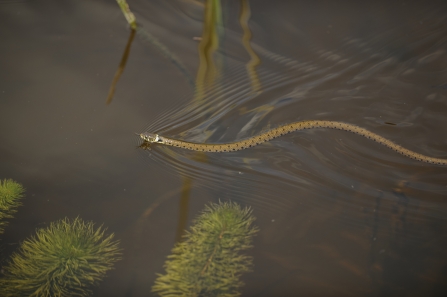
Terry Whittaker/2020VISION
The grass snake is our longest snake, but don’t be scared – it is completely harmless. Unlike the adder, grass snakes spend most of their time in water. Found in wetland and grassland habitats, and even in gardens with a pond nearby, they hunt amphibians like frogs and newts as well as fish, small mammals and birds.
The beautiful markings of the grass snake are unmistakeable: greenish in colour with a yellow and black collar, and black markings down the sides. Females lay eggs in rotting vegetation such as compost heaps, and like all reptiles, grass snakes hibernate between October and April. You are most likely to see one hunting in a pond during spring.
Where to see grass snakes:
- No official hotspots, but there are scattered records across Lancashire
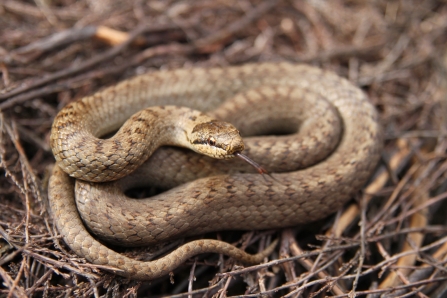
Steve Davis
Other reptiles in the UK
There is one UK reptile that we don’t have in the North West: the smooth snake. This is the UKs rarest reptile and only found in a handful of southern lowland heath sites. It is the UKs answer to the boa constrictor, coiling up around its prey to subdue it and often crush it to death.
Reptile-watching tips
Thanks to dedicated habitat restoration work by staff and volunteers here at Lancashire Wildlife Trust, reptiles have the chance to thrive across many of our nature reserves. That said, they are shy by nature and there is no guarantee of seeing one. Here are some tips:
- Tread lightly and carefully, as reptiles are sensitive to vibrations and may scarper at the first hint of a footstep.
- Look for reptiles early in the morning, when they are basking but haven’t had chance to warm up properly yet. They will be less likely to run or slither away.
- Keep your eyes peeled around south-facing walls, rocks and tree stumps that catch the best of the sunlight.
- Carefully check under the corrugated iron mats left for reptiles on some nature reserves.
- Adders are particularly sensitive to disturbance, so watch from a respectable distance and don’t be tempted to try and pick them up.
Have you seen any of these reptiles on your adventures through Lancashire, Greater Manchester or North Merseyside? Share your pictures with us on Facebook, Twitter or Instagram.


